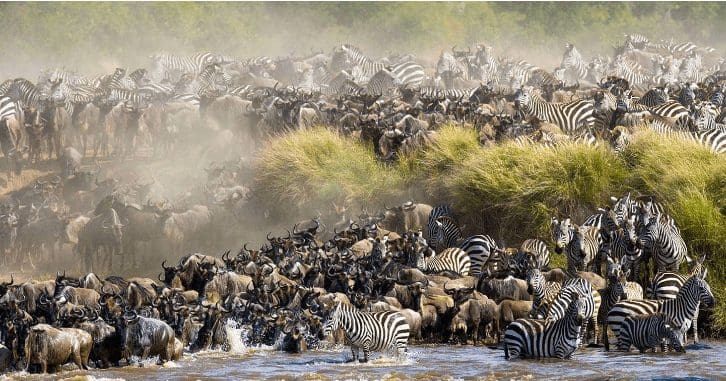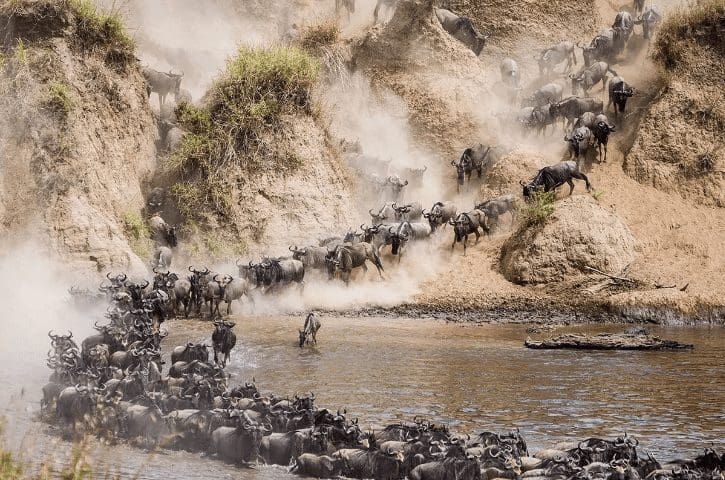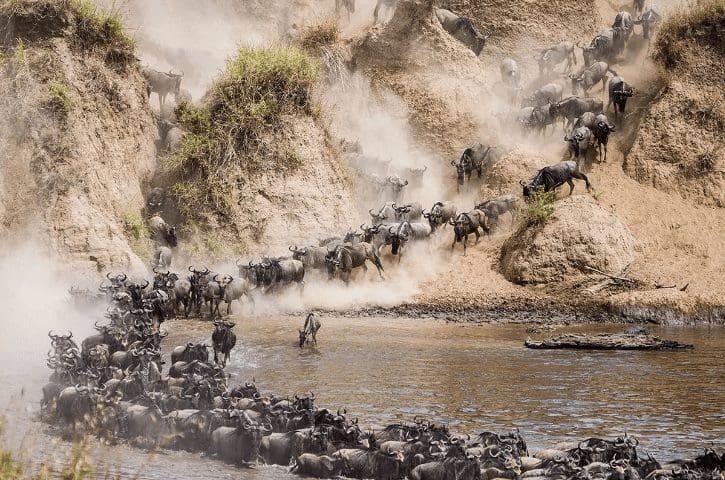The Great Migration Masai Mara is one of nature’s most awe-inspiring spectacles, where millions of wildebeest, zebras, and gazelles journey across the vast plains. This incredible event, set against the backdrop of the Masai Mara’s stunning landscapes, offers a once-in-a-lifetime experience for nature lovers and adventurers.
If you’re looking for an unforgettable safari, witnessing this migration is a must. The Masai Mara ecosystem plays a crucial role in maintaining biodiversity in East Africa, supporting both wildlife and local communities. By visiting, you’ll not only experience breathtaking wildlife encounters but also contribute to the conservation of this vital region.
What is the Great Migration Masai Mara?

The Great Migration Masai Mara is an extraordinary natural event that takes place every year, showcasing the incredible movement of millions of animals across the Serengeti-Masai Mara ecosystem. This migration involves over 1.5 million wildebeest, 200,000 zebras, and countless gazelles as they make their way through East Africa in search of greener pastures. Driven by the seasonal rains, this vast movement is not just about survival but also a fascinating display of nature’s cycles.
The migration typically begins in Tanzania’s Serengeti, where the herds follow the rains northward into Kenya’s Masai Mara. It’s a continuous loop, with the animals covering around 1,200 miles throughout the year. The search for food and water dictates their movement, and timing is crucial, with animals facing starvation if they fall behind.
One of the most iconic and dramatic moments of the Great Migration Masai Mara happens during the river crossings, particularly at the Mara River. Here, herds must plunge into the crocodile-infested waters, risking their lives as they attempt to cross to the other side. These river crossings are both perilous and mesmerizing, capturing the raw power of nature.
Predators play a major role in this event. Lions, leopards, and cheetahs shadow the herds, picking off weaker individuals. In the rivers, massive Nile crocodiles lie in wait, their stealth and power a deadly challenge for migrating animals. The presence of these predators adds another layer of intensity to the migration, making it a thrilling spectacle for those fortunate enough to witness it.
This extraordinary journey not only showcases the resilience and instincts of these animals but also plays a vital role in maintaining the delicate balance of the Masai Mara ecosystem, highlighting the importance of this protected region.
Best Time to See the Great Migration in Masai Mara
The best time to witness the Great Migration Masai Mara spans from July to October, with each month offering its unique spectacle and wildlife interactions.
- July: By late July, the herds begin to leave the dry plains of Tanzania’s Serengeti, heading north into the lush Masai Mara in search of food and water. This is when you can witness one of the most dramatic moments of the migration — the Mara River crossings. Thousands of wildebeest, zebras, and gazelles risk their lives to cross crocodile-infested waters, creating a thrilling display of survival.
- August: By August, the majority of the herds will have reached the Masai Mara. This is also when the predators, especially lions, leopards, and cheetahs, are most active, hunting the weakened or straggling animals. For visitors, this month offers exceptional opportunities to see intense predator-prey interactions up close.
- September: In September, the herds enjoy a more peaceful time as they graze across the lush plains of the Masai Mara. The drama of river crossings subsides, and it’s a perfect time for safari game drives through the Masai Mara National Reserve. Wildlife viewing is plentiful, and the calm atmosphere allows for incredible photography and wildlife encounters.
- October: As October arrives, the short rains begin to fall, signaling the end of the migration season in the Masai Mara. By late October and early November, the herds start their long journey back to the Serengeti, continuing the endless cycle of migration.
Each month between July and October offers its own unique window into the Great Migration Masai Mara, making it one of the most awe-inspiring natural events on Earth.
Top Locations to Experience the Great Migration Masai Mara
Experiencing the Great Migration Masai Mara is a breathtaking adventure, and choosing the right locations can enhance your safari. The Masai Mara offers numerous vantage points and unique experiences to get the most out of this incredible wildlife event. Here are some of the top locations and experiences to consider.
Viewing Points at the Mara River

The Mara River is the heart of the migration spectacle. It’s here that you can witness the dramatic river crossings, where thousands of wildebeest and zebras bravely leap into crocodile-infested waters.
Some of the best spots along the river include Lookout Hill and the Main Crossing Point. These areas are prime locations for spotting wildlife as the herds gather before making their perilous crossing.
Best Camps and Lodges for Migration Viewing
For an unforgettable experience, staying at a strategically located camp or lodge can make all the difference. Some of the best options include:
- Governors’ Camp: Located near the Mara River, this camp offers easy access to prime migration viewing spots.
- Kichwa Tembo Tented Camp: Nestled on the Oloololo Escarpment, this camp provides stunning views of the migration below.
- Mara Serena Safari Lodge: Set on a hill, this lodge gives you a panoramic view of the river and the plains, ideal for watching the herds in motion.
These camps offer not only luxury and comfort but also a front-row seat to the migration action.
Unique Ways to Experience the Migration

To elevate your experience, consider some unique ways to view the migration:
- Hot Air Balloon Safaris: A sunrise hot air balloon safari offers a bird’s-eye view of the herds moving across the plains. This peaceful, floating perspective provides an unmatched vantage point for watching the animals in their natural habitat.
- Guided Walking Safaris: For a more intimate encounter, guided walking safaris give you a close-up view of the wildlife and landscape, allowing you to feel connected to the migration in a personal way.
- 4×4 Game Drives: Traditional game drives remain the most popular way to experience the Great Migration Masai Mara, offering flexibility and proximity to the action, whether you’re following predators or watching the herds.
These locations and experiences offer you a range of ways to immerse yourself in one of the world’s greatest wildlife events.
Why the Great Migration in Masai Mara is Unique
The Great Migration in the Masai Mara offers an experience unlike any other, even when compared to Tanzania’s Serengeti. While both regions are part of the same ecosystem, the Masai Mara provides a more intimate and thrilling way for you to witness this extraordinary event.
Comparison with the Serengeti in Tanzania
While the Serengeti’s vast plains are impressive, the Masai Mara has a unique advantage. Its rolling hills and concentrated landscape make it easier for you to spot wildlife up close, allowing for more consistent viewing of the migration. The Mara River crossings are more frequent and dramatic here, giving you a front-row seat to one of nature’s greatest spectacles. Unlike the Serengeti, where crowds can be overwhelming, the Masai Mara offers a more personal and action-packed experience, making your safari truly unforgettable.
Differences in Animal Behavior and Tourist Experience
In the Masai Mara, the concentration of predators is higher, creating even more exciting opportunities for you to witness the circle of life unfold. Lions, leopards, and cheetahs are particularly active here, and their interactions with the migrating herds are a breathtaking sight. With the Mara’s smaller, more condensed space, you’ll feel closer to the action, whether you’re watching a lion hunt or a herd crossing the river.
Your experience in the Masai Mara is also tailored for variety. Whether you prefer the thrill of a private game drive or the serene perspective of a hot air balloon safari, the Masai Mara offers multiple ways to immerse yourself in this incredible event.
Role of Maasai Culture and Conservation in the Masai Mara
One thing that makes the Great Migration Masai Mara truly special is the connection to the Maasai people. As you explore the region, you’ll have the opportunity to engage with the local Maasai culture, learning how they’ve lived in harmony with wildlife for centuries. Many camps and lodges offer cultural experiences, allowing you to gain insight into how the Maasai contribute to the conservation of the land and animals.
By visiting the Masai Mara, you’re not only witnessing the Great Migration but also supporting important conservation efforts that protect this natural wonder. Your journey helps preserve the ecosystem, and the involvement of the Maasai ensures a respectful and sustainable approach to tourism.
In the Masai Mara, you’ll experience the migration in a way that brings you closer to the action, the culture, and the natural beauty of East Africa.
Planning Your Safari for the Great Migration Masai Mara
Planning your safari to witness the Great Migration Masai Mara is an exciting process, and with the right tips, you can ensure that your experience is unforgettable. From booking at the right time to choosing the best tour operators, here’s how to make the most of your adventure.
Booking Tips to Maximize Your Migration Experience
To truly immerse yourself in the Great Migration Masai Mara, it’s essential to book early, especially if you plan to visit during the peak months (July to October).
Camps and lodges fill up quickly, so securing your spot months in advance ensures you’ll get the best views and accommodation. Consider booking a stay near the Mara River, where the river crossings happen. If possible, try to plan for at least 4-5 days, as this will give you the flexibility to catch the migration’s most dramatic moments.
Another tip is to be aware of the timing of the rains, as this can affect when and where the herds will be moving. Work with your tour operator to track migration patterns and make sure you’re in the right place at the right time.

The Mara Wanderlust: Your Trusted Tour Operator for the Great Migration
At The Mara Wanderlust, we specialize in providing a seamless and unforgettable safari experience during the Great Migration Masai Mara. Our team is dedicated to ensuring that your trip is perfectly tailored to your needs, from arranging top-tier accommodations to organizing thrilling game drives that take you right to the heart of the migration action.
We pride ourselves on having experienced guides who know the Masai Mara intimately. They will take you to the best spots to witness river crossings, predator interactions, and the incredible mass movement of wildlife. With The Mara Wanderlust, you can rest assured that every detail of your safari is handled with care, allowing you to fully immerse yourself in the breathtaking natural wonders of the Masai Mara.
Let us handle all the logistics, so you can focus on enjoying the adventure of a lifetime. Whether you’re seeking luxury lodges or more rustic camps, we’ll find the perfect accommodation for your stay, all while making sure you don’t miss a single moment of this extraordinary wildlife event.
FAQs
When is the best time to see the Great Migration Masai Mara?
The best time to witness the Great Migration Masai Mara is from July to October, when the herds cross into the Masai Mara. This period also features the dramatic Mara River crossings, offering unparalleled wildlife viewing opportunities.
How long does the Great Migration last?
The Great Migration is a year-round cycle, with animals moving between Tanzania’s Serengeti and Kenya’s Masai Mara. However, the most dramatic moments in the Masai Mara, including river crossings, generally occur from July to October.
Can I see other animals besides wildebeest during the migration?
Yes, in addition to wildebeest, you’ll see zebras, gazelles, and various predators such as lions, cheetahs, and crocodiles. The Great Migration Masai Mara also attracts elephants, giraffes, and many bird species, offering a rich diversity of wildlife.
Is it safe to witness river crossings up close?
Yes, it’s generally safe to view river crossings up close with a professional guide. Your safety is a priority, and The Mara Wanderlust ensures you observe these dramatic events from secure vantage points while respecting the animals’ space.
What are the best spots for viewing the Great Migration Masai Mara?
The Mara River is the prime location for viewing the migration, particularly the thrilling river crossings. Other great spots include Lookout Hill and Musiara Marsh, which offer fantastic views of the herds and predator-prey interactions.

